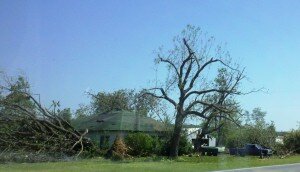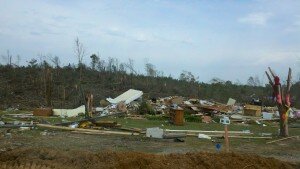The Importance of Getting Good & Ready
 Today’s post comes from Sharon Tewksbury-Bloom, an AmeriCorps Alum and professional volunteer leader.
Today’s post comes from Sharon Tewksbury-Bloom, an AmeriCorps Alum and professional volunteer leader.
You don’t expect disaster to strike where you live.
Most people do not plan for disaster when choosing a place to rent or when choosing a place to live.
I have rented homes from at least five different landlords and have never discussed what might happen in the event of a natural disaster. Do they have homeowners insurance? What does it cover? I have never kept a disaster kit so that I would be ready to evacuate.
The first time I even thought about how I would handle a natural disaster, was when we were living in northern Virginia during snowmaggedon. As the snow piled up around the house I started looking online for information about what I should do if we lost power or if the pipes froze, or if one of the old trees surrounding our home was heavily weighted down and fell on the house.
Most disasters do not build up slowly, allowing you time to catch up on your preparedness knowledge and resources. Earlier this year, my fiancé Jay and I traveled across the south, following the path of destruction that a swath of tornadoes had left behind.
Volunteering with the fire department in Vilonia, Arkansas, we spoke to an older man who had lived there, in “tornado alley” for almost 30 years and had never been hit by a tornado. Now, he was cleaning up the debris from an F2 which stormed right down his street, knocking out power for over a week, destroying several homes, and killing two community members.
He was a tough guy, prepared for disaster with a seldom used storm shelter stocked with supplies, but he teared up recalling how the tornado had suddenly changed direction, one minute headed miles outside of town and the next bearing down directly towards his house.

Tornado damage in Vilonia, Arkansas
Many of his neighbors were caught by surprise, running for shelter at the last second or being stuck in the storm in their car. Up until the funnel cloud was actually in sight, many people still didn’t believe that they could be the victim of a tornado.
We left Arkansas and headed to volunteer for disaster relief in Alabama. After seeing the damage that an F2 could do, I was afraid of what we would find in towns hit by F5 storms.
In small towns like Hackleburg, the destruction was immense. Residents, work crews, and volunteers were basically clearing everything that had been there in order to rebuild from scratch.
The tornado victims that affected me the most, because I could see myself in them, were the people renting homes. We would usually arrive at an affected town at least a week after the damage had been done. Utility crews had already been hard at work restoring power and most homeowners had already submitted insurance claims and were expecting money to rebuild with.
These homeowners were badly shaken up by what they had experienced, but they were able to take healthy steps towards rebuilding their homes and their lives. Renters however, were often left wondering about their fate. Those renting homes that were destroyed were at the mercy of the homeowner to make repairs or to contact insurance.

Tornado damage in Hackleburg, Alabama, at least one week after the tornado.
Some renters found out that the home was uninsured or only partially insured. The renters we spoke to did not have renters insurance and therefore, the property that had been damaged or lost in the storm could not be replaced. Many renters are new to the area they are living in and are less familiar with what services are available or less connected to neighborhood organizations that serve to assist residents after disaster.
Being Good & Ready is about deliberate actions you take to be prepared, as well as regular activities that help you be a connected community member, which will also benefit you in the event of a disaster.
What I have learned, through seeing the effects of disaster up close, is that it can happen to you and the effort it takes to be prepared is worth every minute and penny. Through HandsOn Network’s Good and Ready campaign, you are encouraged to Create a Plan, Build a Kit, Help Others, and Get Trained.
These are all great steps towards the broader goal of thinking through how you will react in the event of a disaster and strengthening your connections with your neighbors and local community so that you can quickly get assistance and be able to quickly offer assistance.
Disaster can affect anyone, so please use this extra motivation of the Good and Ready campaign to get prepared. I’m making my pledge today.
Sharon Tewksbury-Bloom is currently traveling throughout the United States and Canada with her fiance Jay, volunteering along the way. As an AmeriCorps Alum and professional volunteer manager, Sharon is now focused on now experiencing volunteerism from the perspective of a short term volunteer. She writes about her experiences at http://www.servicedriven.org.



2 Comments to “The Importance of Getting Good & Ready”